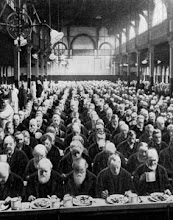And yet here I am, if only briefly, at the very outset of this adventure, stepping up to this most modern of podiums, preparing to speak. Thank heavens I can't see you, Audience, and thank whatever lies beyond Heaven that you cannot see me, the way my hands tremble as they clutch my notes, which vibrate like the snares on a drum, the drumbeat provided, of course, by my own nervous, flashing heart
Salinger, why have you done this to me, you rascal! Like Frost's famous speaker, I shall be remembering this somewhere ages and ages hence. Well, given my actual age, perhaps "ages" is a bit of an overstatement....
It's best to begin before my courage fails me; having spent some time in higher education, I have been asked to comment on some long lost literary forms. I include the first of these dispatches here:

With all the discussion on the clevelandpoetics blog about poetic forms, I thought it would be interesting to take a few moments to contemplate some of poetry’s lesser-known structures. While some of these strategies have fallen by the wayside over the years—some for obvious reasons, others, like the dodo, waylaid by cruel and unfortunate circumstance—it is of the utmost importance that we remember that at one time these poetic expressions all had their adherents and champions. Let us begin.
The Deterministica: Originally appearing in eighteenth century England, the Deterministica’s arrival coincides with the conclusion of the Great Parachute Wars of the early 1780’s. In fact, the form’s progenitor, Philip Whaley-Horseman, had been serving out the conclusion of his indentured servitude (a twenty year term) when he noticed a preponderance of determiners in the standard parachute assembly directions, specifically the articles a, an, and the. Whaley-Horseman’s first endeavors focused primarily on these initial three, but later went on to include not only determiners but nearly every preposition extant at the time.
Love
a with each
the across
an both
the within
a the, a an, an a
Unfortunately, the above poem—one of the first daring experiments in language conducted by Whaley-Horseman, who established the memorable and moving hinge of the a/the/an/the/a pattern—proved to be the form’s greatest poetic expression. Later efforts, such as Sir Edmund Roque’s preposition-laden “Beneath But By, Beyond Like Near” (famous if only for its insipid lines “behind among behind/between behind, into behind/inside, inside, inside behind”) and Willary Prederick’s epic, “Next,” so-named for the fact that the title word repeats for 700 lines in the middle), fell far short of the form’s initial brilliance, and Whaley-Horseman spent the remainder of his life attempting to prove that his genius was indeed more than dumb luck. He died in his 21st year, after reciting his masterpiece and then leaping from mid-way up a rather large tree with an improperly assembled parachute.
Next: Gettouda Pointillism...
Editor's note: How apropos da Vinci's drawing is. Look out, world! I am plummeting toward you!
